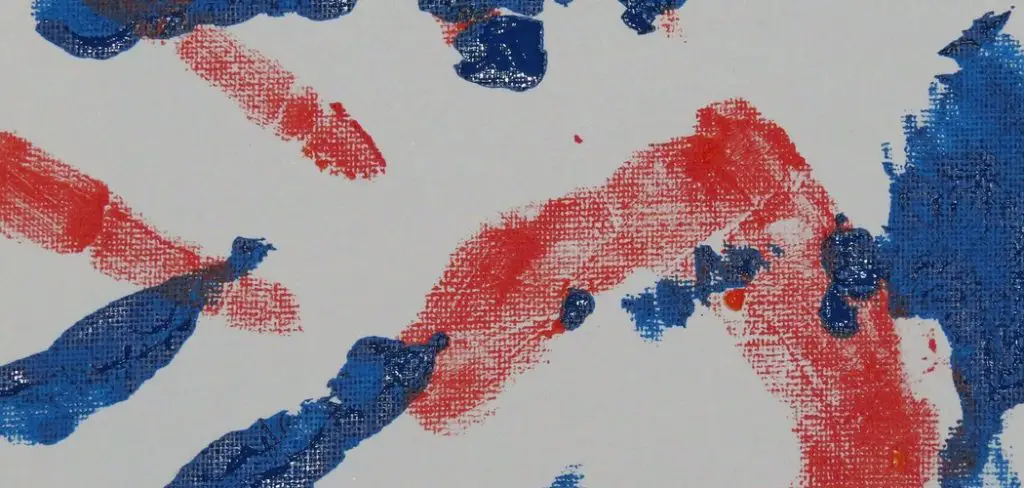To fix cloudy varnish on an acrylic painting, gently sand the affected area and apply a new layer of varnish. Now, let’s discuss how you can effectively restore the clarity of your acrylic painting.
The beauty and vibrancy of an acrylic painting can be compromised when the varnish becomes cloudy. This can be frustrating for artists who want their work to be displayed in its true brilliance. Thankfully, there are ways to fix this issue and restore the clarity of your painting.
We will explore various techniques and steps to help you fix cloudy varnish on your acrylic painting. By following these methods, you can regain the original shine and depth of your artwork, ensuring it looks its best for years to come.
Understanding Acrylic Painting Varnish
A clear and glossy varnish is an essential finishing touch for any acrylic painting. Not only does it protect the artwork from dirt, dust, and UV damage, but it also enhances the colors and adds a professional touch. However, sometimes varnishing acrylic paintings can present a few challenges, with one of the most common issues being cloudy or hazy varnish. In this section, we’ll explore what acrylic painting varnish is, its importance, and the challenges that come with varnishing acrylic paintings.
What Is Acrylic Painting Varnish?
Acrylic painting varnish is a protective coating that is applied on top of dried acrylic paintings. It is usually a clear and transparent liquid that dries to a glossy or matte finish, depending on the artist’s preference. Varnish serves as a barrier between the painting and external elements, providing a protective layer that can be removed if necessary. It not only safeguards the artwork but also enhances the colors, giving them a vibrant and finished look.
Why Is Varnishing Important?
Varnishing acrylic paintings is crucial for several reasons:
- Protection: A varnish layer acts as a shield, safeguarding the painting from dust, dirt, and moisture, which can cause damage over time.
- UV Protection: Varnish contains UV inhibitors that help prevent the fading of colors due to prolonged exposure to sunlight.
- Enhancement: Varnish brings out the true colors of the painting, accentuating their vibrancy and depth, making it visually appealing.
- Consistency: Varnish creates a uniform sheen across the entire painting, eliminating any irregularities in the surface texture and creating a cohesive look.
- Longevity: By protecting the painting from external factors, varnish helps extend its lifespan, ensuring that it remains in its prime condition for years to come.
Challenges With Varnishing Acrylic Paintings
Varnishing acrylic paintings can present a few challenges that artists need to be aware of:
- Cloudy or Hazy Varnish: One of the most common issues when varnishing acrylic paintings is the appearance of a cloudy or hazy finish. This can be caused by various factors, including improper mixing of varnish, not waiting for the painting to dry completely, or using a low-quality varnish.
- Brush Strokes: Acrylic varnish can sometimes leave visible brush strokes on the surface of the painting, affecting its overall appearance. This can be minimized by using a soft brush and applying thin, even layers of varnish.
- Drying Time: Varnish can take some time to dry fully, and during this period, the painting may be susceptible to dust or other particles settling on its surface. Artists should ensure they have a dust-free environment and avoid touching the painting until the varnish has cured.
- Compatibility: Not all varnishes are compatible with every brand of acrylic paint. It is crucial to choose a varnish that is specially formulated for use with acrylic paintings to avoid any potential issues.
Now that we have delved into what acrylic painting varnish is, its importance, and the challenges associated with it, we can move on to addressing the issue of cloudy varnish and exploring effective solutions to fix it.

Preparing Your Painting For Varnishing
Before applying varnish to your acrylic painting, it is crucial to properly prepare the surface. This step is often overlooked, but it plays a vital role in ensuring a successful varnishing process. By taking the time to clean the painting surface, fix any issues or damages, and allow for proper drying time, you can achieve a professional and long-lasting varnish that enhances the beauty of your artwork.
Cleaning The Painting Surface
To start preparing your painting for varnishing, you need to clean the surface. Dust, debris, and even fingerprints can affect the final varnish result. Follow these steps to clean your acrylic painting:
- Gently dust the painting using a soft brush or a clean, lint-free cloth to remove loose particles.
- If there are any stains or spots, dampen a microfiber cloth with a mild soap solution and gently rub the affected areas.
- Ensure the painting is completely dry before proceeding to the next step.
Fixing Any Issues Or Damages
Before varnishing, it’s important to address any issues or damages on the painting surface. This will prevent the varnish from trapping imperfections, resulting in cloudy or uneven areas. Here’s what you can do to fix common issues:
- If there are visible brush strokes or texture irregularities, carefully sand the surface with ultra-fine sandpaper to create a smoother finish.
- If there are any flaking or loose paint areas, use a small brush to apply a thin layer of acrylic medium over the problem spots, allowing it to dry completely.
- For minor scratches, apply a small amount of acrylic paint to a fine brush and gently touch up the damaged areas.
Allowing Proper Drying Time
Patience is key when it comes to varnishing your acrylic painting. Rushing the process can lead to cloudy varnish or even damage your artwork. Follow these guidelines to ensure proper drying time:
- Allow your painting to fully cure for at least two weeks before applying varnish. This ensures that the paint layers are completely dry and stable.
- Make sure you’re working in a well-ventilated area with moderate temperature and humidity levels. Extreme conditions can affect the drying process and the varnish application.
- When applying varnish, layer it thinly and evenly, allowing each coat to dry completely before adding another.
Applying Varnish To Your Acrylic Painting
Adding a layer of varnish to your acrylic painting can enhance its colors and protect it from dust, dirt, and UV rays. However, sometimes the varnish may turn cloudy, which can be frustrating for any artist. In this article, we will discuss the common issue of cloudy varnish on acrylic paintings and provide step-by-step solutions to fix it. Let’s start by understanding how to choose the right varnish for your artwork.
Choosing The Right Varnish
When it comes to choosing the appropriate varnish for your acrylic painting, there are a few factors to consider. Firstly, you need to decide between a glossy, satin, or matte finish based on your personal preference and the effect you want to achieve. For a traditional glossy shine, opt for a glossy varnish. If you prefer a softer sheen, satin varnishes work well. Finally, matte varnishes are ideal for creating a non-reflective surface. Keep in mind that the varnish should be specifically formulated for acrylic paintings to ensure compatibility and longevity.
Another important consideration is whether to use solvent-based or water-based varnish. Solvent-based varnishes are durable and provide a glossy finish, but they emit strong fumes and require careful ventilation during application. On the other hand, water-based varnishes are odorless and more beginner-friendly, offering easy cleanup with soap and water. Approach the decision based on your workspace, preference, and experience level.
Applying Varnish With A Brush
If you decide to apply varnish with a brush, follow these steps:
- Clean the painting: Ensure that the surface of your acrylic painting is clean and free from dust or debris. Use a soft, lint-free cloth or a gentle brush to remove any particles.
- Prepare your workspace: Find a dust-free and well-ventilated area to work in. Place your painting on a flat surface, preferably elevated on blocks or cans, allowing easy access to the edges.
- Stir the varnish: Gently stir the varnish to mix it thoroughly, avoiding the formation of air bubbles. However, make sure not to shake it vigorously, as this can introduce unwanted bubbles into the varnish.
- Apply the varnish: Dip your brush into the varnish, making sure to load it evenly with a moderate amount of varnish. Begin applying the varnish in long, smooth strokes, working from the top to the bottom of the painting. Apply the varnish thinly and evenly, ensuring no areas are missed. Avoid over-brushing, as it can cause streaks or cloudiness.
- Allow to dry and repeat: Let the first coat of varnish dry completely, as mentioned in the varnish instructions. Once dry, apply subsequent thin coats, if desired, to achieve the desired level of sheen. Make sure to follow the drying times suggested by the manufacturer between each coat.
Using A Spray Varnish
If you prefer using a spray varnish, here is a simple guide to follow:
- Protect your surroundings: Cover the area surrounding your painting with a large drop cloth or newspaper to avoid any accidental overspray.
- Shake the can: Shake the spray varnish can vigorously for a few minutes to ensure proper mixing.
- Test on a sample surface: Before applying the varnish to your painting, it is recommended to test it on a small sample surface to see if it produces the desired finish and avoids any unexpected reactions.
- Apply the varnish: Hold the can about 12 inches away from the painting surface and spray the varnish with short, even strokes, overlapping each pass slightly. Apply several thin coats rather than one thick coat to prevent running or drips.
- Allow to dry and repeat: After each coat, let the varnish dry as per the manufacturer’s instructions. Apply additional coats if necessary, ensuring each layer is dry before moving forward. Take your time and avoid rushing the process.
By following these guidelines and using the proper technique, you can successfully apply varnish to your acrylic painting without encountering cloudy or uneven results. Remember to choose the right varnish, whether it’s brush or spray varnish, and always read and follow the instructions provided by the manufacturer. With a bit of patience and care, your acrylic masterpiece will shine beautifully for years to come.

Caring For Your Varnished Acrylic Painting
To fix cloudy varnish on your acrylic painting, start by gently wiping the surface with a soft cloth dampened with a mixture of mild soap and water. If the cloudiness persists, apply a thin layer of fresh varnish using broad, horizontal strokes for an even finish.
Allow it to dry completely before assessing the clarity. Repeat the process if necessary, keeping in mind to protect the painting from dust and debris during the drying period.
Avoiding Direct Sunlight And Humidity
Varnishing your acrylic painting helps protect it from dust, dirt, and other pollutants, but caring for your varnished artwork doesn’t end there. To maintain the quality of your varnished acrylic painting and prevent it from becoming cloudy, it is important to take some precautions:
- Avoid exposing your varnished acrylic painting to direct sunlight for long periods. Sunlight can cause the varnish to become yellow or discolored over time.
- Similarly, high humidity can also lead to cloudiness in the varnish. It is advisable to store your painting in a dry area with low humidity levels.
Regularly Cleaning And Dusting
Cleaning and dusting your varnished acrylic painting on a regular basis can help prevent cloudiness and maintain its vibrancy:
- Use a soft, lint-free cloth or a feather duster to gently remove any dust or debris from the surface of your painting.
- Dampen a clean cloth with a mild soap solution, specifically made for cleaning acrylic paintings, to gently wipe away any stubborn dirt or stains. Always test the cleaning solution on a small, inconspicuous area of the painting before applying it to the entire surface.
- After cleaning, ensure the painting is completely dry before applying a new coat of varnish.
Dealing With Varnish Yellowing
Varnish yellowing can be a common issue with varnished acrylic paintings. Here are a few tips to prevent or minimize varnish yellowing:
- Choose a high-quality archival varnish that is specifically made for acrylic paintings. These varnishes are less likely to yellow over time compared to lower-quality varnishes.
- Apply the varnish evenly in thin layers, allowing each layer to dry completely before applying the next. Thick layers of varnish can contribute to yellowing.
- If your varnish has already yellowed, do not attempt to remove it as it can damage the paint layers underneath. Instead, consult a professional art restorer for advice on how to address the issue.
Frequently Asked Questions For How To Fix Cloudy Varnish On Acrylic Painting
How Do You Fix Cloudy Varnish On Acrylic Painting?
To fix cloudy varnish on an acrylic painting, gently clean the surface using a soft brush or lint-free cloth dipped in mild soap and water. Rinse with clean water and dry thoroughly. Apply a new layer of varnish, making sure to follow the manufacturer’s instructions.
Allow it to fully dry before handling the painting again.
What Causes Varnish On Acrylic Paintings To Become Cloudy?
Cloudy varnish on acrylic paintings can be caused by various factors such as applying varnish too soon, not mixing the varnish properly, or using a low-quality varnish. Additionally, environmental conditions like humidity or temperature fluctuations can also contribute to the cloudiness.
It is important to follow proper application techniques and use high-quality varnish to avoid this issue.
Can You Remove A Cloudy Varnish Without Damaging The Acrylic Painting?
Yes, you can remove a cloudy varnish from an acrylic painting without damaging it. Use a mild solvent like isopropyl alcohol or acrylic varnish remover on a soft cloth or cotton ball. Gently rub the varnish in a circular motion until it starts to dissolve.
Wipe off the varnish residue with a clean cloth. Repeat if necessary, and ensure the painting is dry before reapplying a fresh coat of varnish.
Conclusion
To achieve a clear and vibrant finish on your acrylic painting, it’s essential to address any issues with cloudy varnish. By following the steps outlined you can effectively fix the cloudiness and bring out the true colors of your artwork.
Remember to use a gentle touch and take your time to obtain the desired results. With these techniques, your acrylic painting will be transformed into a stunning masterpiece.

